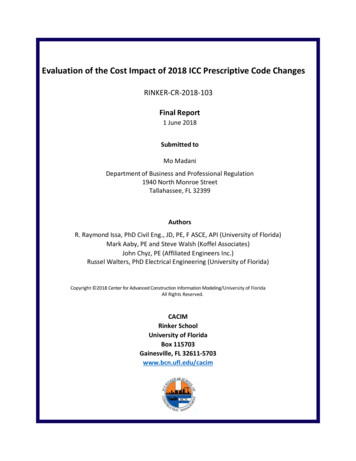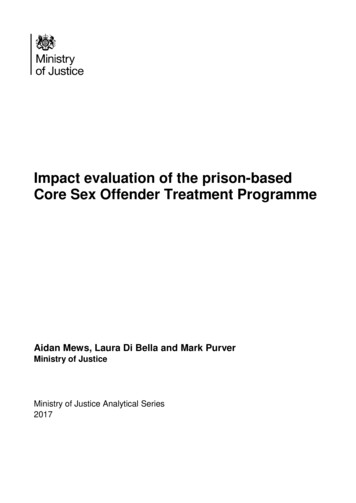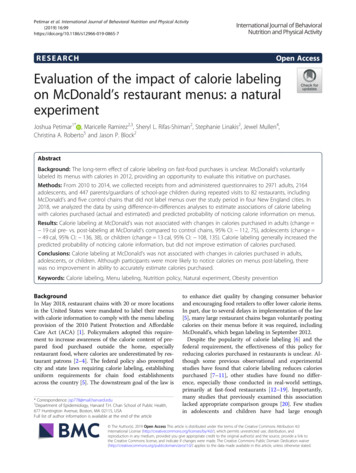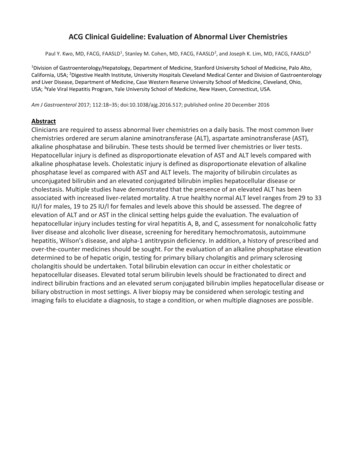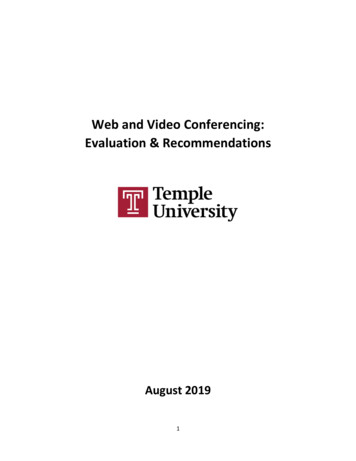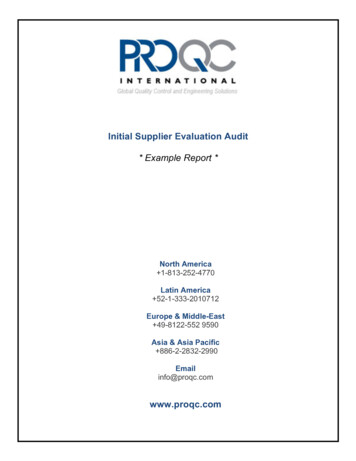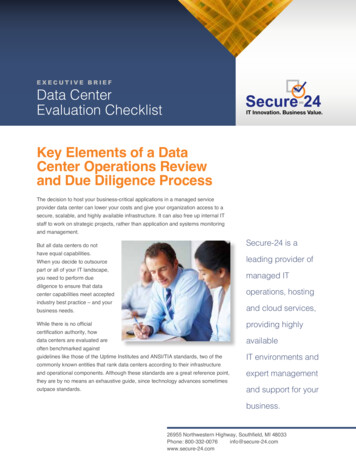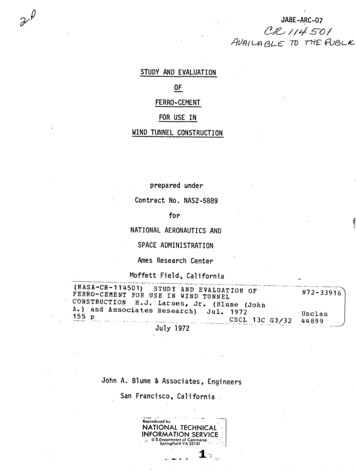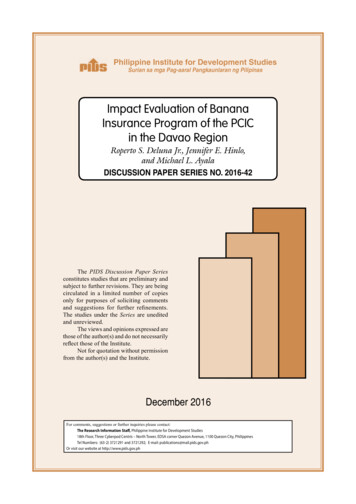
Transcription
Philippine Institute for Development StudiesSurian sa mga Pag-aaral Pangkaunlaran ng PilipinasImpact Evaluation of BananaInsurance Program of the PCICin the Davao RegionRoperto S. Deluna Jr., Jennifer E. Hinlo,and Michael L. AyalaDISCUSSION PAPER SERIES NO. 2016-42The PIDS Discussion Paper Seriesconstitutes studies that are preliminary andsubject to further revisions. They are beingcirculated in a limited number of copiesonly for purposes of soliciting commentsand suggestions for further refinements.The studies under the Series are uneditedand unreviewed.The views and opinions expressed arethose of the author(s) and do not necessarilyreflect those of the Institute.Not for quotation without permissionfrom the author(s) and the Institute.December 2016For comments, suggestions or further inquiries please contact:The Research Information Staff, Philippine Institute for Development Studies18th Floor, Three Cyberpod Centris – North Tower, EDSA corner Quezon Avenue, 1100 Quezon City, PhilippinesTel Numbers: (63-2) 3721291 and 3721292; E-mail: publications@mail.pids.gov.phOr visit our website at http://www.pids.gov.ph
IMPACT EVALUATION OF BANANA INSURANCE PROGRAM OF THEPHILIPPINE CROP INSURANCE CORPORATION (PCIC) IN THEDAVAO REGIONRoperto S. Deluna, Jr., Jennifer E. Hinlo and Michael L. AyalaTERMINAL REPORTSCHOOL OF APPLIED ECONOMICSUniversity of Southeastern PhilippinesDavao City1
TABLE OF CONTENTSList of Tables . 3List of Figures . 5List of Acronyms . 8Abstract . 9INTRODUCTION. 10Objectives of the Project . 12Significance of the Project . 12Insurance for banana . 13REVIEW OF RELATED LITERATURE . 15METHODOLOGY . 18Conceptual Framework of the Study . 18Sources of Data and Methods of Data Collection . 20Impact Estimation . 20RESULTS AND DISCUSSION . 25Profile of the Respondents . 25Housing, Household and Productive Assets . 33Access to Economic and Agricultural Services . 37Farm Characteristics, Production and Farm Income . 39Credit Availment Practices . 52Income and Other Receipts . 56Shocks and Coping . 57Significant Shocks Experienced During the Past Two Years by Banana Farmers in Region 57Average decline in household income due to shocks experienced . 59Recovery and Coping Strategy . 62Risk Mitigation Strategies in Crop Production . 67Awareness on Agricultural Insurance . 68Utilization of Indemnity Claim Payment . 73Willingness to Pay for Agricultural Insurance . 75Impact Assessment . 77SUMMARY OF MAJOR FINDINGS . 85CONCLUSIONS AND RECOMMENDATIONS . 89REFERENCES . 91ANNEXES . 922
LIST OF TABLESTable No.DescriptionPage No.Table 1. Distribution of Survey Participants, Region XITable 2. Average age and number of years of farming experience by treatment groupTable 3. Social Protection Index of farmer respondents by treatment group, 2014-2015Table 4. Household Agricultural Assets Index, Household Consumer Durables Index,Household Livestock Ownership Index of farmer respondents, 2014-2015.Table 5. Distribution of Banana Farmers in Region XI (Davao) that Availed ofAgricultural Loans by Cropping Season and Treatment GroupTable 6. Percent Distribution of Banana Farmers in Region XI (Davao), By Type ofCreditor And Treatment Group, 2014 and 2015Table 7. Percent Distribution of Loans By Type of Creditor (Formal/ Informal),Type of Crop, Region and Treatment Group, 2014 and 2015Table 8. Average Loan Amount, Loan Proceeds and Interest Amount By Type of Creditor(Formal/ Informal), By Type of Crop, Region and Treatment Group, 2014Table 9. Ranking of Problems Facing Farmers Today , by Treatment Group,Region XI DavaoTable 10. When First Availed of Agricultural Insurance, By Type of Crop, Regionand Treatment GroupTable 11. Avail of Agricultural Insurance Regularly, By Type of Crop, Region andTreatment GroupTable 12. Reason for Nonregular Availment of Agricultural Insurance, By Type of Crop,Region and Treatment GroupTable 13. Reason for Non-Availment of Agricultural Insurance, By Type of Crop,Region and Treatment GroupTable 14. Reason for Availment of Agricultural Insurance, By Type of Crop, Regionand Treatment GroupTable 15. Source of Premium Payment for Agricultural Insurance, Banana, Region XIand Treatment GroupTable 16. Rating of Product and Service Characteristics of PCIC, By Treatment Group,Region XI-DavaoTable 17. Received Indemnity Claims in Time for Next Season's Planting, ByType of Crop, Region and Treatment GroupTable 18. Utilization of Indemnity Claim Payment, By Type of Crop, Region andTreatment GroupTable 19. Average Amount of Indemnity Claim Received By Cause of Loss, Typeof Crop, Region and Treatment GroupTable 20. Willingness-To-Pay for HVCC Insurance (Banana), By Bid Amount andTreatment Group, Region XI-DavaoTable 21. Willingness to pay for premium for farmers not willing to pay quotedprices, in PhP2025333752535455686969707273747576767778783
Table 22. Paired t test results for differences of mean income from banana productionand from all agricultural activities between 2014 and 2015 by treatmentgroup.Table 23. Independent sample t test results for differences of mean income frombanana Production and from all agricultural activities between withand without insurance, and between with claims and without claims,2014-2015.Table 24. Results of Propensity Score MatchingTable 25. Estimated coefficients on factors affecting log of income fromBanana productionTable 26. Estimated coefficients on factors affecting log of income fromagricultural related79818283854
LIST OF FIGURESFigure No.DescriptionPage No.Figure 1.Framework for impact assessment of PCIC agricultural insurance programs.19Figure 2. Distribution of sex of farmers by treatment group.26Figure 3. Distribution of marital status of farmers by treatment group.26Figure 4. Distribution of highest education attainment of farmers by treatment group. 27Figure 5. Distribution of farmers’ primary occupation by treatment group.28Figure 6. Distribution of farmers’ class of worker by treatment group.28Figure 7. Distribution of farmers’ nature of employment by treatment group29Figure 8. Distribution of farmers’ secondary occupation by treatment group29Figure 9. Proportion of household members who are salaried workers and dependencyRatio, 2014-201530Figure 10. Distribution of membership of farmer in farmers’ associations/cooperatives. 30Figure 11. Penetration rate of private insurance membership and percentage ofHouseholds with at least one cooperative/mutual aid member, 2014-201531Figure 12. Percentage of households with members that are beneficiaries ofGovernment social programs, 2014-201532Figure 13. Percentage of households with members that received agricultural supportsAssistance, 2014-201533Figure 14. Percent distribution of type of housing and type of building ofFarmer respondents.34Figure 15. Construction material of outer wall (house) and roof (house) of farmerRespondents, by treatment group34Figure 16. Distribution of tenurial status of house and lot of farmers by treatment group 35Figure 17. Availability of electricity and source of drinking water of farmer respondents 35Figure 18. Main source of water for drinking of farmer respondents by treatment group. 36Figure 19. Type of toilet facility in household of farmers.36Figure 20. Awareness to economic support and agricultural services.38Figure 21. Availment to economic support and agricultural services.38Figure 22. Average Physical Area Planted by Treatment and Farm Size in Region XI,2015 to 2015.39Figure 23. Cropping System used by Farmers by Treatment and Farm Size, 2014-2015. 40Figure 24. Percentage distribution of Farmer’s Tenurial Status by Treatment and FarmSize, 2014 and 201541Figure 25. Percentage of Banana varieties planted by farmers, by treatment andBy farm size, 2014 and 2015.41Figure 26. Distribution of Parcels Covered and Not Covered by Insurance in5
2014 and 2015.Figure 27. Total Physical Area Covered by Crop Insurance and respondent type,2014 and 2015Figure 28. Percent distribution of farmers who experienced crop damagedBut did not receive indemnity claims, by farm size.Figure 29. Proportion of Income (%) derived from different sources of BananaFarmers in Region XI, 2014Figure 30. Proportion of Income (%) derived from different sources of BananaFarmers in Region XI, 2015.Figure 31. Number of farmers with indemnity claims by type and farm size,2014 and 2015Figure 32. Total number of farmers with indemnity claims and average amount ofindemnity claims, 2014 and 2015Figure 33. Cause of Loss Connected to Indemnity by Farmer and Respondent Type,2014 and 2015Figure 34. Percent distribution of farmers who experienced crop damaged but didnot receive indemnity claims, by farm sizeFigure 35. Average amount of indemnity per farmer, by type and farm size,2014 and 2015Figure 36. Farmer’s reason for not receiving claims despite having damagedcrop, by farm size.Figure 37. Average cost of production per farmer, by type and farm size, 2014Figure 38. Average cost of production per farmer, by type and farm size, 2015Figure 39. Average net income and difference from 2014 and 2015 per farmer,by type and farm sizeFigure 40. Proportion of Income (%) derived from different sources of BananaFarmers in Region XI, 2014Figure 41. Proportion of Income (%) derived from different sources of BananaFarmers in Region XI, 2015Figure 42. Distribution of the Most Severe Significant Shocks Experienced Duringthe Past Two Years by Banana Farmers in Region XI, By Treatment GroupFigure 43. Distribution of the Second Most Severe Significant Shocks ExperiencedDuring the Past Two Years by Banana Farmers in Region XI, By TreatmentGroupFigure 44. Average decline in household income in the most severe natural disaster,Region XIFigure 45. Average decline in household income in the most severe man-madedisaster, Region XI42434344454546464747484950515656575859596
Figure 46. Recovery status and recovery period from shock by treatment group,Region XIFigure 47. Food-related coping strategies for most severe shocks experienced,Region XIFigure 48. Non-food coping strategies for most severe shocks experienced, Region XIFigure 49. Education coping strategies for most severe shocks experienced, Region XIFigure 50. Health coping strategies for most severe shocks experienced, Region XIFigure 51. Receipt of assistance coping strategies for most severe shocks experienced,Region XIFigure 52. Additional sources of income coping strategies for most severe shocksexperienced, Region XIFigure 53. Current condition of farmers two years ago and now, Region XIFigure 54. Risk mitigation strategies during wet season, Region XIFigure 55. Risk mitigation strategies during wet season, Region XI616263636465656667677
LIST OF ACRONYMSATTAverage treatment effect on the treatedBBTDBanana Bunchy Top DiseaseCCTConditional Cash TransfersCLOACertificate of Land Ownership AwardCLTCertificate of Land TitleCPBRDCongressional Policy and Budget Research DepartmentDADepartment of AgricultureDARDepartment of Agrarian ReformFGDFocus Group DiscussionFSFarm SizeGSISGovernment Service Insurance SystemIPCCIntergovernmental Panel on Climate ChangeLBPLand Bank of the PhilippinesLGULocal Government UnitMPCIMultiple Peril Crop InsuranceNLNotice of lossPAOProvincial Agricultural OfficePCICPhilippine Council for Agriculture, Forestry and National Resources Research andDevelopmentPhilippine Crop Insurance CorporationPIDSPhilippine Institute for Development StudiesTATeam of AdjustersPCARRD8
IMPACT EVALUATION OF BANANA INSURANCE PROGRAM OF THE PHILIPPINE CROPINSURANCE CORPORATION (PCIC) IN THE DAVAO REGIONRoperto S. Deluna, Jr., Jennifer E. Hinlo and Michael L. AyalaABSTRACTAgricultural crop insurance is a risk management tool to counter shocks and risks inbanana production. It is a mechanism for farmers to be protected from unexpected risks and atool for them to recover from the shocks experienced. The Philippine Crop Insurance Corporation(PCIC) is mandated to provide insurance protection to the country’s agricultural producers,particularly the subsistence farmers, against natural disasters and other perils. This paperevaluated how agricultural insurance made an impact to banana growers in terms of managingrisks and their well-being. The inputs, outputs and outcomes relative to risk, agriculturalinvestment, productivity and access to credit are documented to provide options and strategiesin improving the agricultural crop insurance in the country.Agricultural crop insurance at its present coverage level is not sufficient to create impacton stabilizing income of banana farmers hit by shocks. This could be attributed to low insurancecoverage which is only 55% of the production cost of banana. Without the subsidy of thegovernment, and status quo on coverage and premium rate, crop insurance in the country willnot be sustained in the case of banana. Agricultural insurance has not fully penetrated the wholebanana industry yet because of the lack of information dissemination. Hence, educationalprograms to inform the farmers about the benefits of modern risk management schemes inbanana should be prioritized because the major driver towards sustainable development ofagriculture in the Philippines is to instill resiliency of farmers through agricultural crop insurance.Keywords: Philippine Crop Insurance Corporation, Davao Region, agricultural crop insurance,banana, impact evaluation,9
INTRODUCTIONBanana is a tropical plant growing in all regions of the Philippines. It is the leading fruitcrop in terms of area, volume and value of production. It is considered as a table fruit since somevarieties are eaten as fresh fruit while others are cooked and processed into chips, powder,paper, ketchup and other preparations. It is an important source of income for small farmers whoconstitute up to 80% of the banana growers because it is an annual crop that bears fruitthroughout the year. There are about 5.9 million farm households depending on banana as theirmajor source of income. It can also be used as an intercrop with fruit trees to provide additionalincome for the households. In Davao Region, it is a widely grown fruit, planted as a componentof farming system or as a main crop in large plantations.Agriculture is characterized by high risks and uncertainties, risks that are harder to controland these risks are getting higher with time. These risks and uncertainties include credit,fluctuating yield, income and unpredictable weather. Banana, like any other agriculture crop, isnot immune or isolated from these risks and uncertainties. By nature, Filipino farmers are mostlyrisk-averse. This is quite alarming considering that more than 90% of the agricultural workers areclassified as smallholders and any failed season of cropping is disastrous for the whole family.Given that climatic changes are becoming precarious, unpredictable and deadlier every year,mitigating measures such as crop insurance could soften the blow of this climatic aberration andprovide a relief for the poor farmer and his family. A farm safety net is therefore important tohelp family farmers mitigate risks.Given these realities, a number of schemes have evolved to mitigate these perceived andreal risks, based on the economic theories of efficiency and utility. These measures include,among other things, guaranteed prices, subsidized credit, and crop insurance. Crop insurance isperceived to be a significant component to improve agricultural competitiveness of the farmersas it shields them from these unpredictable and uncontrollable risks increasing the welfare of therural areas, leading to higher efficiency and utility. It is generally recognized as a basic instrumentfor maintaining stability in farm income, through promoting technology, encouraginginvestment, and increasing credit flow in the agricultural sector. It contributes to self-relianceand self-respect among farmers, since in cases of crop loss they can claim compensation as amatter of right (Chandrakanth, 1976). Thus, crop insurance does not obliterate the risks butsimply spreads the risks and cushions the shock of crop loss by assuring farmers protectionagainst natural hazards beyond their control. This means that it reduces part of the lossesresulting from such risks and uncertainties. In general, the basic principles of crop insurance areas follows: (1) uncertainty faced by individual farmers is transferred to the insurer through theirparticipation in large numbers, for which benefit, farmers over a wide area, i.e., horizontalspreading of risks over a wide and vertical spreading over many years; (2) the risk premiumreflects the group risk assumed by the insurer; an indemnity is liable to be paid to the individualfarmer when a loss is incurred due to causes beyond his control, as long as he maintains theinsurance contract valid by paying the premium without default; and, (3) also, losses incurred inbad years are compensated from resources accumulated in good years (Dandekar, 1976).10
While crop insurance underlies the competitiveness of the country’s economy, they alsoconstitute a major expenditure component for the farmers and for the government. There is nowa growing concern on the money of the government that is allocated to the crop insurancesystem and the results for the society as a whole, in terms of efficiency and equity (Souza, 1997).In addition, the advancement in technology is creating increasing pressure from government andthe community for accountability (Altbach, Gerdahl and Gunport, 1999; Cleary, 2001 by Lee,2001). It appears that there are real concerns ad issues on the crop insurance program. In a studyconducted by the Worldbank (2010)
Table 14. Reason for Availment of Agricultural Insurance, By Type of Crop, Region and Treatment Group 73 Table 15. Source of Premium Payment for Agricultural Insurance, Banana, Region XI and Treatment Group 74 Table 16. Rating of Product and Service Char

